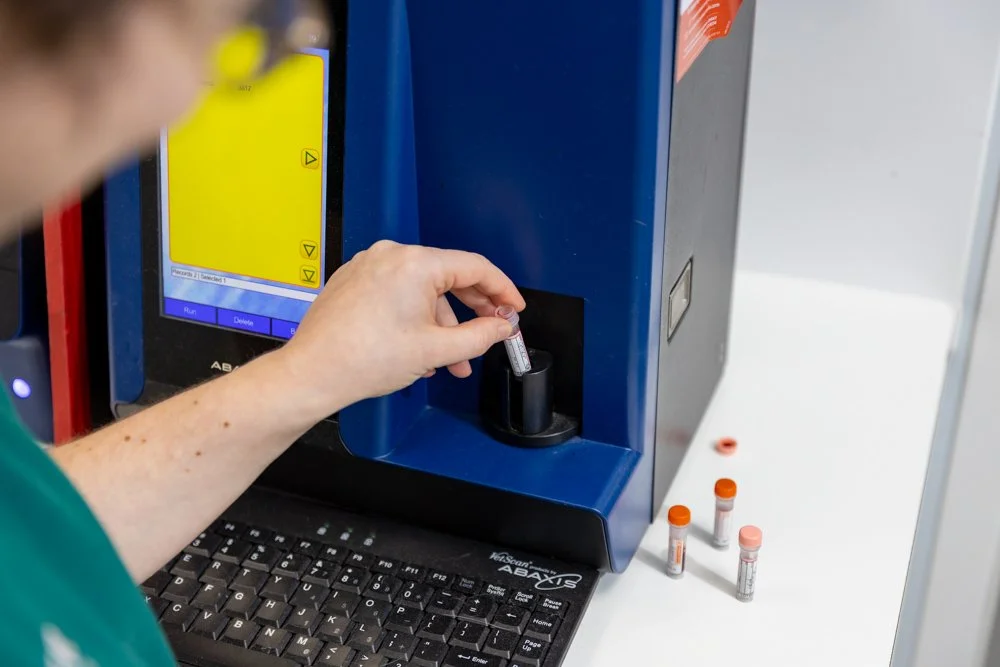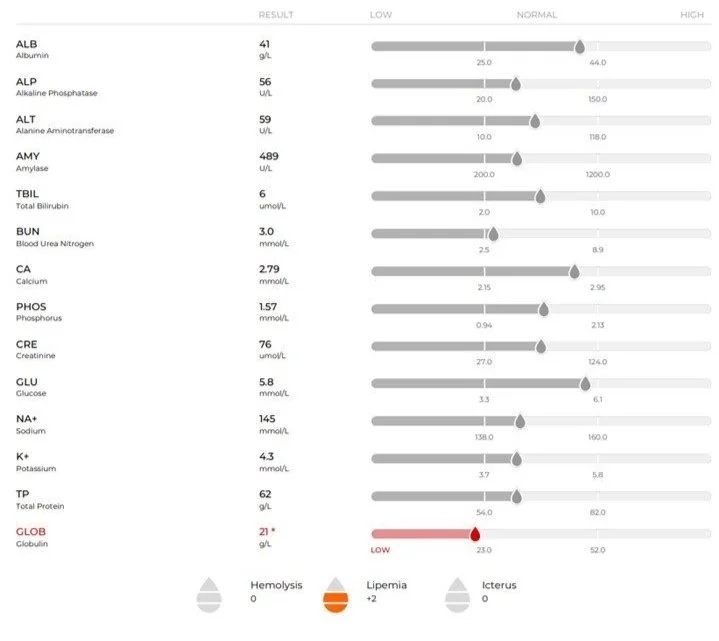Has your Pet had a Blood Test? Essential Things to Know…
Authored by James Horner
What are Blood Tests and What Can They Tell Us?
Blood tests are a fundamental step in veterinary investigations, providing critical information that physical examinations alone cannot reveal.
These tests primarily consist of comprehensive biochemistry and haematology, each offering insights into different aspects of your pet’s health.
Quick Read:
Haematology: Focuses on white and red blood cells.
Biochemistry: Analyses organ-specific biomarkers.
Blood tests help veterinarians identify which parts of the body might be affected by disease and assess the body's response. While some blood profiles provide clear diagnoses, others may raise more questions, necessitating further tests. Biomarkers and blood parameters can change rapidly, making repeated tests close together sometimes necessary.
Blood Tests Explained:
Blood tests are essential tools for assessing your pet's health, especially since organ function cannot always be evaluated through physical exams alone. Often, a series of blood tests are needed to pinpoint a problem. Vets interpret these tests by comparing results against a "normal range"—values that 95% of healthy individuals fall within.
When a test result falls outside this normal range, it suggests a potential problem that needs further investigation. However, individual variations can complicate interpretations, as what is normal for one animal might be abnormal for another and vice versa. This is why repeated sampling can be crucial.
Common Diagnoses from Blood Tests:
Haematology – White and Red Blood Cells:
White Blood Cells (WBC): Elevated white blood cell counts often indicate infections or inflammation.
Neutrophils: Increase with bacterial infections.
Lymphocytes: Increase with long-term inflammation, viral infections, or cancer.
Eosinophils: Increase with parasitic infections or allergies.
Monocytes: Increase due to stress or chronic inflammation.
Basophils: Generally of low relevance in most conditions.
Red Blood Cells (RBC): Important parameters include the total RBC count and haematocrit.
Total RBC Count: Reflects the number of red blood cells; can indicate dehydration (high count) or blood loss and destruction (low count).
Haematocrit (HCT): Similar to total RBC count; shows the proportion of blood volume occupied by red blood cells, indicating hydration status and blood health.
Determining the type of bladder stones your pet has is essential for effective treatment, as different types require different management strategies. A veterinary surgeon can perform tests to identify the composition of the stones and recommend appropriate treatment options.
Biochemistry – Organ-Specific Biomarkers:
Protein Levels:
Total Protein (TP): Commonly used to assess hydration or loss of protein. Comprises of albumin and globulin. Variations in these specific markets can indicate issues even if TP is normal.
Albumin (ALB): High levels suggest dehydration or fluid loss; low levels suggest leakage (e.g. through intestines or kidneys).
Globulin (GLOB): Related to immune function; low levels suggest leakage, while high levels might indicate severe infections or cancer.
Liver Enzymes:
Alkaline Phosphatase (ALP) and Alanine Aminotransferase (ALT): Elevated levels indicate liver damage, which could be primary or secondary, due to other issues like drug reactions or diseases such as Cushing's.
Total Bilirubin (TBIL): Indicates liver function; deviations warrant further investigation as they suggest impaired liver function.
Pancreatic Enzymes:
Amylase (AMY): Increased levels suggest pancreatitis or gastrointestinal issues. Follow on tests that are more specific, like Canine and Feline Pancreatic Lipase Immunoreactivity (cPLI/fPLI) are used for suspected primary pancreatitis.
Kidney Markers:
Blood Urea Nitrogen (BUN) and Creatinine (CRE): High levels indicate kidney issues. These elevations, known as azotaemia, can stem from dehydration, primary kidney disease, or urinary tract obstructions.
Azotaemia Types:
Pre-renal Azotaemia: Due to dehydration or poor kidney perfusion.
Renal Azotaemia: Indicates primary kidney disease or failure.
Post-renal Azotaemia: Caused by urinary tract blockages or infections.
Diabetes and Stress:
Glucose (GLU): Elevated glucose can result from stress, recent feeding, or diabetes. Mild increases suggest stress or recent meals, while high levels strongly indicate diabetes. Further testing and urine samples help confirm the diagnosis. We don’t often see low levels but this could be a nutritional issue, or a very rare cancer.
Electrolytes:
Calcium (CA), Phosphorous (PHOS), Sodium (Na+), Potassium (K+): Levels influenced by kidney health, hydration, diet, certain cancers, and thyroid function. Minor changes can be corrected with fluids, but major changes indicate serious issues requiring intensive care.
Conclusion:
Blood tests are typically the first step in diagnosing diseases in pets. Haematology focuses on blood cells, while biochemistry examines organ-specific biomarkers. Normal results are valuable, ruling out severe illnesses and guiding further diagnostics. Combining blood test results with a thorough patient examination ensures effective and comprehensive veterinary care. A normal blood test is a positive outcome, indicating a high chance of recovery and is never a waste of money or effort.



